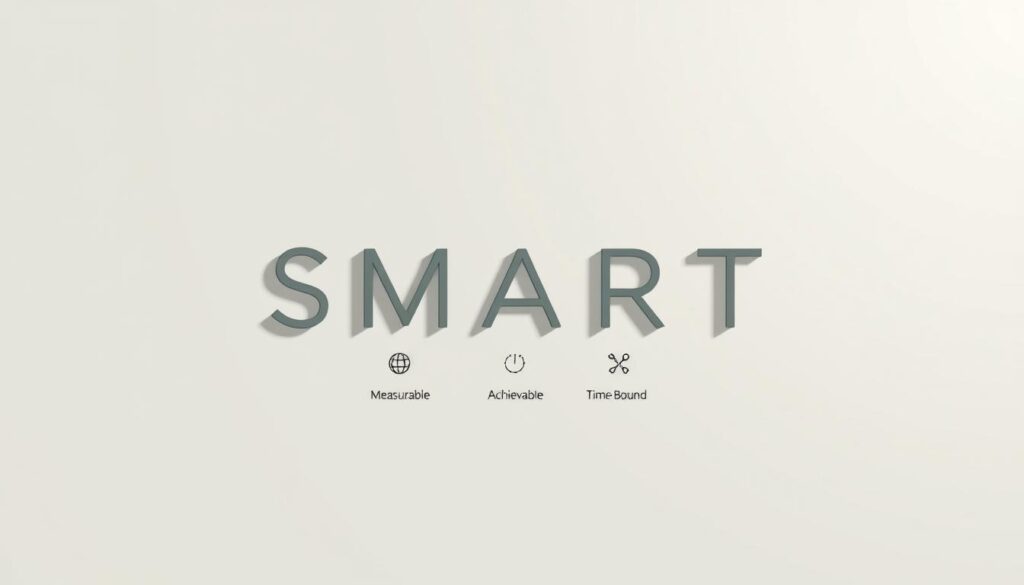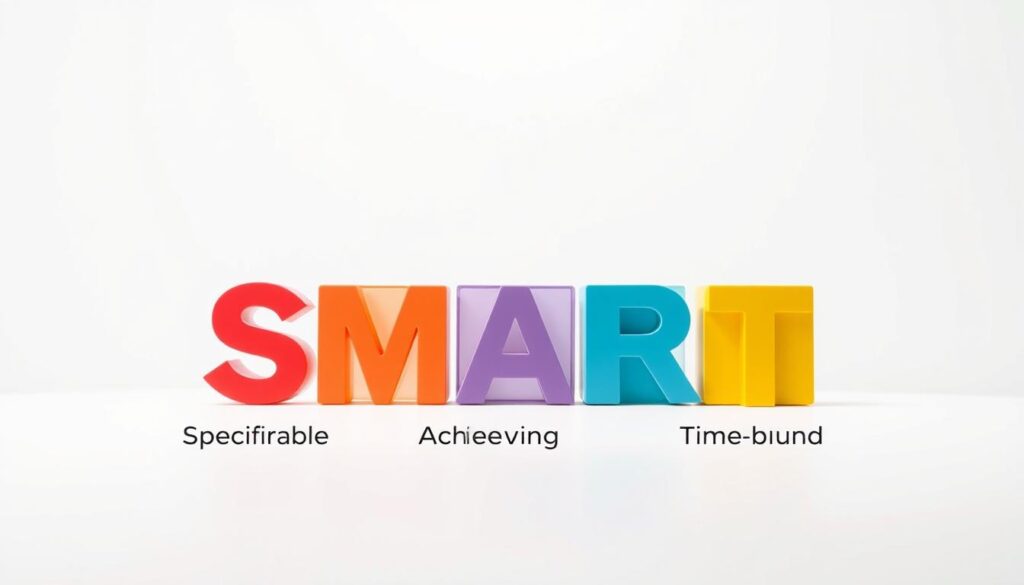As Stephen Covey once said, “All things are created twice. There’s a mental or first creation, and a physical or second creation.” This idea shows how important planning is at the start. It’s key when setting goals for self-improvement.
When we start growing, the way we set goals matters a lot. Two popular ways are SMART and WOOP. They both help us reach our goals, but they work differently. Knowing the details of each helps us pick the best one for our Personal Growth path.
Key Takeaways
- Understand the core principles of SMART and WOOP goal-setting techniques.
- Discover the benefits and drawbacks of each method.
- Learn how to choose the most effective goal-setting strategy for your needs.
- Explore how to integrate the chosen method into your daily life for better results.
- Find resources to support your goal-setting journey, such as planners available on amazon.com.
Understanding Personal Growth
Starting a journey of personal growth changes your life in big ways. It needs dedication, knowing yourself, and a desire to grow. Learning about personal growth is key as you start this journey.
What is Personal Growth?
Personal growth, or personal development, is about getting better at things and feeling good. It’s about setting goals that match your values and dreams. This journey is different for everyone, with its own ups and downs.
Importance of Setting Goals
Setting goals is very important for personal growth. It gives you a clear path and helps you focus. By setting SMART or WOOP goals, you make a plan for your growth. Goals keep you motivated and on track.
How Goals Drive Development
Goals give you a clear purpose and direction. They help you see where you need to improve and how to get better. Achieving your goals boosts your confidence and keeps you moving forward.
| Aspect of Personal Growth | Description | Benefit |
|---|---|---|
| Self-Awareness | Understanding your strengths, weaknesses, and motivations | Improved decision-making and goal-setting |
| Skill Development | Acquiring new skills and improving existing ones | Increased confidence and competence |
| Resilience | Learning to handle challenges and setbacks | Greater adaptability and perseverance |
By understanding and embracing personal growth, you can reach your full capacity. You can live a more meaningful and satisfying life.
Introduction to SMART Goals
In the world of goal setting, SMART has become a key term. It helps people reach their dreams by providing a clear plan. SMART goals make personal growth and development more focused and effective.
What Does SMART Stand For?
SMART stands for Specific, Measurable, Achievable, Relevant, and Time-bound. Each part is important for setting goals that are both realistic and possible to achieve.
- Specific: Clearly defining what you want to achieve.
- Measurable: Quantifying your goal to track progress.
- Achievable: Ensuring the goal is realistic based on your resources.
- Relevant: Aligning the goal with your broader aspirations.
- Time-bound: Setting a specific deadline for completion.
Advantages of SMART Goals
The SMART framework has many benefits for setting goals. It makes goals clear and achievable. This leads to a sense of accomplishment and keeps people motivated.
| Advantage | Description |
|---|---|
| Clarity | SMART goals provide a clear direction and focus. |
| Measurable Progress | Tracking progress becomes straightforward with quantifiable objectives. |
| Increased Motivation | Achieving smaller, manageable milestones boosts motivation. |

Common Challenges with SMART Goals
While SMART goals are very helpful, some people face challenges. Common problems include finding it hard to make goals measurable or achievable.
To solve these problems, break down big goals into smaller tasks. Also, regularly check and adjust your goals as needed.
Exploring WOOP Goals
WOOP Goals offer a fresh way to set and reach our dreams, promoting a growth mindset. This method goes beyond old goal-setting ways. It invites us to adopt a more complete strategy.
What is the WOOP Framework?
The WOOP framework is a new way to set goals. It involves identifying your Wish, Outcome, Obstacle, and Plan. It helps you beat obstacles and reach your goals by thinking deeply about what you want to do.
Breaking down your goal into these parts helps you make a clear plan. It also prepares you for any hurdles. This way, you gain self-empowerment to manage your goals better.
Benefits of Using WOOP Goals
One big plus of WOOP Goals is that it makes you think about possible obstacles. By knowing these challenges, you can plan how to get past them. This makes your goal easier to reach.
- Enhances goal clarity
- Prepares you for possible obstacles
- Fosters a proactive approach to goal achievement
Comparison to Traditional Goals
Unlike old goal-setting methods, WOOP Goals look at the whole picture. They consider obstacles and plan for them. This makes your goal more realistic and attainable.
This shows how WOOP Goals stand out. They focus on self-empowerment and a growth mindset.
A Deep Dive into the SMART Framework
The SMART framework helps you set effective goals. It makes your goals clear and achievable. This framework is key to success in goal-setting.
Specific Goals: Defining Clarity
Starting with specific goals is essential. They give you a clear direction. For example, “I want to be healthier” is vague. But “I will reduce my body fat percentage to 20% in 6 months” is specific.
To set specific goals, ask yourself:
- What exactly do I want to achieve?
- Why is this goal important to me?
- Who is involved in achieving this goal?
Measurable Goals: Tracking Progress
A goal without a measurable outcome is lost. Measurable goals help you track progress. For instance, “I will increase my daily step count to 10,000 steps in 3 months” is measurable.
To make goals measurable, consider:
- How will I track my progress?
- What metrics will I use to measure success?
| Goal Type | Example | Measurement Metric |
|---|---|---|
| Physical Health | Increase daily step count | Steps per day |
| Professional Development | Improve public speaking skills | Number of presentations given per quarter |
Achievable Goals: Setting Realistic Targets
Setting achievable goals is important. They should be realistic and based on your current abilities. This way, you avoid disappointment.
To ensure goals are achievable, ask:
- Do I have the necessary resources to achieve this goal?
- Are there any constraints that could hinder my progress?
Relevant and Time-Bound Goals: Keeping Focused
Relevant goals align with your values and long-term plans. They make a big impact on your life. Setting time limits helps you stay focused.
To make goals relevant and time-bound, consider:
- Is this goal aligned with my overall vision?
- What is the deadline for achieving this goal?
By using these elements, you can create a strong goal-setting strategy. It drives personal growth and achievement.

The WOOP Method Explained
The WOOP method is a powerful tool for achieving your goals. It’s a simple, four-step process to help you set and reach your targets.
Wish: Identifying Your Aspirations
The first step is to identify your wish. You need to be clear about what you want to achieve. Be specific and honest with yourself about your desires. Your wish should excite and motivate you.
Outcome: Visualizing Success
After setting your wish, visualize the outcome. Imagine achieving your goal. What does success look like? How does it feel? This step boosts your motivation and helps you focus on your goal.
Obstacle: Recognizing Challenges
Next, recognize the obstacles you might face. These could be internal, like self-doubt, or external, like lack of resources. Knowing your obstacles helps you prepare strategies to overcome them.
Plan: Creating a Concrete Strategy
The final step is to create a plan. Develop a detailed strategy to achieve your wish. Your plan should include specific actions to tackle the obstacles. A clear plan helps you stay focused and reach your goals.
By using the WOOP method, you can improve your self-improvement and personal development. It’s a simple yet effective way to turn your dreams into reality.
Comparing Effectiveness of SMART and WOOP
Exploring goal setting, we find SMART and WOOP methods key. Each has its fans, and picking one can shape your growth path.
Success Rates: What Research Says
Studies show SMART and WOOP can both lead to big wins. SMART goals are clear and easy to follow. WOOP goals use a special technique to boost commitment and resilience.
A study showed WOOP users hit their goals more often. This is because WOOP helps plan for hurdles. Yet, SMART goals keep you focused and goal-oriented.

Adaptability: One Size Fits All?
There’s no one best method for everyone. SMART or WOOP depends on your situation and likes. For example, WOOP is great for tackling tough challenges.
- SMART goals work best when you need clear, measurable goals.
- WOOP goals are ideal when you face many obstacles.
Personal Preferences: What Works for You?
Choosing between SMART and WOOP should match your goals and preferences. Think about what you need for mindset enhancement and goal setting.
Know your strengths and challenges. This helps pick the right method for your growth journey.
How to Choose the Right Goal-Setting Method
There are many goal-setting methods out there. Finding the right one for you can change your life. Think about what fits your personality and life situation.
Assessing Your Personality and Style
Knowing your personality and style is key. If you like structure, the SMART goal framework might be for you. If you prefer a more holistic approach, WOOP goals could be better.
Looking back at your goal-setting experiences can help. Think about what worked and what didn’t. This self-discovery helps find the best method for you.
Evaluating Life Circumstances
Your current life situation affects your goal-setting choice. If you’re going through big changes, WOOP might be better. If your life is stable, SMART goals could work well.
Think about your daily life, commitments, and challenges. This helps pick a method that fits your lifestyle. It helps you grow and reach your goals.
Seeking Guidance from Professionals
Getting advice from professionals can be very helpful. Coaches or therapists can give you personalized advice. They know your situation well.
Working with professionals keeps you on track and motivated. They tailor strategies for you, helping you reach your dreams.
Real-Life Applications of SMART Goals
SMART goals are powerful because they turn dreams into real achievements. They give a clear plan to reach goals. This helps both people and groups succeed.
Success Stories of Individuals
James Clear, author of “Atomic Habits,” used SMART goals to boost his habits. He set specific, measurable, achievable, relevant, and timely goals. This helped him reach his goals.
Tim Ferriss also used SMART goals in his life. He focused on clear goals and made plans to achieve them. This kept him productive and happy.

Organizations Embracing SMART Goals
Many companies have seen benefits from SMART goals. For example, Microsoft and IBM used them to grow and work better. They set goals that were clear and reachable.
- Microsoft improved its products and made customers happier with SMART goals.
- IBM made more money and grew its market share by streamlining sales with SMART goals.
Personal Transformations Through SMART Goals
SMART goals help people change their lives. They set goals that are clear and can be reached. This helps people get better physically, financially, and skill-wise.
Julie, a single mother, started her own business with SMART goals. She set specific goals and made a detailed plan. This made her business a success.
These stories show SMART goals are key to growth. They help people and groups reach their full success.
Real-Life Applications of WOOP Goals
WOOP goals are more than just a theory. They have been used in real life to help people grow and succeed. By using the WOOP method, people and groups can get past challenges and reach their goals.
Thriving Individuals
Many people have seen success with WOOP. A study in the Journal of Personality and Social Psychology showed WOOP helps set and reach goals better than other methods. Dr. Gabriele Oettingen, who created WOOP, says,
“WOOP is a powerful tool because it helps individuals identify and overcome the obstacles that stand in the way of their goals.”
Jane, a freelance writer, is a great example. She used WOOP to boost her productivity. She set a goal to write more, identified her obstacles, and made a plan. This helped her write more and balance work and life better.
Businesses Utilizing WOOP for Team Goals
Companies also use WOOP to improve team work. A marketing team at a tech firm used WOOP to hit their project goals. They identified challenges and made plans to beat them. This led to successful projects and better teamwork.
A sales team at a retail company also used WOOP to boost sales. They set targets, saw obstacles, and made a plan. They ended up selling more and doing better overall.
Community Examples of WOOP in Action
WOOP is also used in communities to make a difference. A community group used WOOP for a local clean-up event. They set a goal for a cleaner community, saw the challenges, and planned to overcome them. They had a successful event and brought the community together.
These stories show how WOOP can be used in many ways to help people grow and succeed.
Tools and Resources for Goal Setting
Setting goals is more than just wanting to achieve them. You need the right tools and resources. We’ve gathered a list of valuable resources to help you reach your SMART and WOOP goals.
Apps for Tracking SMART Goals
Apps for tracking SMART goals can boost your productivity and focus. Here are some top picks:
- Strides: A goal-setting app that tracks your progress and keeps you motivated.
- Forest: An app that gamifies productivity by growing a virtual forest as you stay focused.
- Trello: A versatile tool for personal goal setting, using boards, lists, and cards to organize tasks.
These apps are easy to find on major app stores. They can be part of your daily routine to support your SMART goals.
Resources for Implementing WOOP
For those interested in the WOOP method, here are some resources to get you started:
- WOOP App: A dedicated app that guides you through the WOOP process, helping you identify wishes, outcomes, obstacles, and plans.
- Online Courses: Platforms like Coursera and Udemy offer courses on goal setting and the WOOP methodology, providing structured learning experiences.
- Books: There are several books available on Amazon that dive into the WOOP strategy, providing insights and practical advice.
You can find these resources on platforms like Amazon. There, you can discover products that align with your goals.
Recommended Books and Courses
For more reading and learning, check out these recommendations:
- “Atomic Habits” by James Clear: A guide to building good habits and breaking bad ones.
- “The Art of Possibility” by Rosamund Stone Zander and Benjamin Zander: A book with practical strategies for a positive mindset.
- MindTools Course: An online course covering personal development and goal setting topics.
These resources aim to enhance your goal-setting journey. They provide the knowledge and tools you need to succeed.

Conclusion: Making the Right Choice for Your Growth
As we wrap up our look at SMART and WOOP goal-setting, it’s clear they both help with personal growth. Knowing the good and bad of each can help you choose the best one for you.
Key Takeaways
The SMART method gives a clear plan for setting goals. It focuses on being specific, measurable, achievable, relevant, and timely. On the other hand, WOOP is more about the whole picture. It looks at wishes, outcomes, obstacles, and planning.
Both methods have worked well in many areas, like personal growth and setting goals for groups.
Embracing Self-Discovery
Keep moving forward in your self-discovery journey. The best goal-setting method is the one that feels right to you. By trying different ways, you’ll be able to reach your dreams and find your true self.
Next Steps
Start your journey to self-empowerment by thinking about your goals. Use what you learned here and start using SMART or WOOP in your life. With hard work and the right attitude, you’ll get closer to your goals and reach your full capacity.
FAQ
What is the main difference between SMART and WOOP goal-setting techniques?
SMART stands for Specific, Measurable, Achievable, Relevant, and Time-bound. It gives a clear structure for setting goals. WOOP, on the other hand, focuses on overcoming obstacles by identifying your Wish, Outcome, Obstacle, and Plan.
How do I know if SMART or WOOP is better for my personal growth?
It depends on your personal style and needs. Think about what works best for you. Understanding both approaches can help you decide.
Can I use both SMART and WOOP goal-setting techniques together?
Yes, you can mix elements of both. This creates a method that fits your needs. It combines the best of both worlds.
What are some common challenges when setting SMART goals?
Setting unrealistic goals and lacking clarity are common issues. Also, not tracking progress can hinder success. Knowing these challenges helps you avoid them.
How can I apply the WOOP method in my daily life?
Start by identifying your wish. Then, think about the outcome you want. Recognize obstacles and plan how to overcome them. This keeps you focused and motivated.
Are there any tools or resources that can help me with goal setting?
Yes, many tools and resources are available. Apps help track SMART goals, while WOOP resources are also out there. Books and courses on goal setting can be found on Amazon.
How can I ensure I’m making progress towards my goals?
Track your progress regularly. Celebrate small wins. Be open to adjusting your approach as needed. This keeps you on track and helps you achieve your goals.
What role does self-reflection play in personal growth and goal setting?
Self-reflection is key for personal growth. It helps you understand your strengths, weaknesses, and motivations. Regular reflection helps refine your approach and makes progress meaningful.
Can goal setting help with self-discovery and personal development?
Absolutely. Goal setting is a powerful tool for self-discovery and personal development. It helps you understand your values, strengths, and areas for improvement.
How can I maintain a growth mindset while working towards my goals?
Embrace challenges and keep going even when faced with obstacles. Stay open to learning and feedback. This mindset keeps you motivated and driven.
Transform your home into a more peaceful and mindful sanctuary. Creating a Zen-inspired home environment is a core part of the “Live.Learn.Create” theme, focusing on peace, mindfulness, and a clutter-free space. Here is a curated list of Zen home items.
The Zen Essentials
These items are the building blocks of a calm, intentional living space.
- Candles & Scents:
- Scented Candles: Look for calming, natural scents like sandalwood, lavender, white tea, or bergamot. Choose candles made with soy or beeswax for a clean burn.
- Essential Oil Diffusers: A minimalist, sleek diffuser made of bamboo, ceramic, or glass.
- Essential Oil Sets: Look for blends specifically for relaxation, focus, or sleep.
- Incense & Burners: Natural incense sticks (e.g., palo santo, sage) with a simple, elegant burner.
The Zen Decor
This is about incorporating natural elements and simple design.
- Natural Materials:
- Wood or Bamboo Trays: For organizing candles, stones, or other small items.
- Ceramic Vases: Simple, unglazed ceramic vases in neutral colors like white, beige, or gray.
- Minimalist Art: Simple line drawings, abstract prints, or nature-inspired artwork.
- Hand-Carved Stone Coasters: Or other small stone sculptures.
- Textiles:
- Linen or Cotton Throws: A soft, neutral-colored throw blanket to add warmth.
- Jute or Sisal Rugs: These add natural texture and grounding to a space.
- Meditation Cushions (Zafu) & Mats (Zabuton): These provide comfort for meditation and add a serene touch to a room.
The Zen Ambiance
These items help create a peaceful sensory experience.
- Lighting:
- Himalayan Salt Lamps: These provide a warm, soft glow.
- Japanese-style Paper Lanterns: For a soft, diffused light source.
- Dimmable Smart Bulbs: To easily control the warmth and brightness of your lighting.
- Sound:
- Tabletop Water Fountains: The gentle sound of running water is incredibly calming.
- Wind Chimes: Made from natural materials like bamboo or metal for a soft sound.
- Bluetooth Speakers: Small, aesthetically pleasing speakers for playing ambient or meditation music.
- Nature:
- Bonsai Trees or Air Plants: Low-maintenance indoor plants that bring life and a touch of nature indoors.
- Zen Gardens: A small, tabletop sand garden with a rake and stones for a meditative ritual.
- Decorative Rocks & Pebbles: For bowls or as a decorative element.
Best Sellers https://amzn.to/3Vet1tI
New Releases https://amzn.to/4mwLjTi
Amazon Movers & Shakers https://amzn.to/4fPsZlP
Mindfulness Coloring Books https://amzn.to/4fQ0wMx
Personal Growth Coloring Books https://amzn.to/4lJeRf0
Health & Wellness https://amzn.to/4oRt24C
Zen Home Decor https://amzn.to/3VeA3i6
Zen Garden Decor https://amzn.to/4mXjT8D
Zen Garden https://amzn.to/3HQTVVB
- Mindfulness & Meditation:
- Physical Wellness:
- Habit & Productivity Tools:
- Books:
- Best-selling personal development books (Mindset, The 7 Habits of Highly Effective People, The Subtle Art of Not Giving a F*ck)
- Books on a variety of skills (coding, photography, writing.)
- Educational Gadgets:
- Smart pens that digitize notes (e.g., Rocketbook)
- Portable scanners for digitizing documents
- Laptops, tablets, and accessories
Create (Creativity, Innovation, Projects)
These products cater to your creative side, whether you are a artists, writer, or DIY enthusiasts.
- Creative Supplies:
- Adult coloring books or “paint-by-sticker” books
- Craft kits (e.g., candle-making, pottery, embroidery)
- Digital Creation Tools:
- General Inspiration & Making:






















